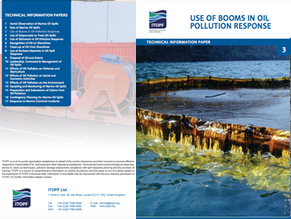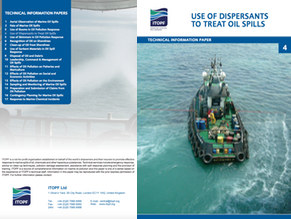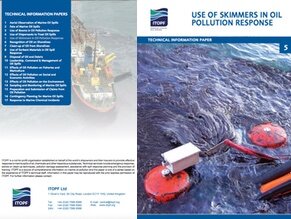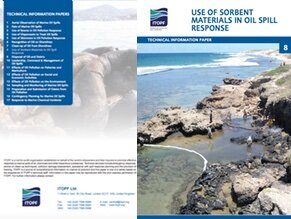Response Techniques
Once oil is spilled at sea, it will naturally spread, fragment and disperse under the influence of wind, waves and currents.
For spills in coastal waters, the oil will often drift towards the shore and become stranded due to the action of waves and tides. In order to contain the oil at the spill site, recover the oil floating on the sea and clean-up any oil that might become stranded on the shore, there are a variety of techniques that can be employed. The prevailing weather and sea conditions, the characteristics of the oiled shoreline and the nature of the oil can all combine to pose challenges to any clean-up operation.
At-Sea Response

Several options are available to respond to oil at sea and can be considered in three broad strategies; containment and recovery, in-situ burning and dispersant application. The selection of the most appropriate strategy will depend on many factors, including; the response resources available, the national and local regulations on oil spill response, the spill scenario and the physical and ecological characteristics of the area impacted by the spill.
Shoreline Clean-Up and Response

The majority of ship-source oil spills occur close to the coast and, as a result, many spills result in contamination of shorelines. Oil reaching stranding on the shore can cause significant environmental and economic impacts and may also largely determine the political and public perception of the scale of the incident, as well as the over costs.
When oil does reach the shoreline, considerable effort may be required to clean the affected areas. It is therefore essential that comprehensive and well-rehearsed arrangements for shoreline clean-up are included in contingency plans. The techniques available for shoreline clean-up are relatively straightforward and do not normally require specialised equipment. However, inappropriate techniques and poor organisation can aggravate the impacts caused by the oil itself.
Explore Documents on Response Techniques
01 المراقبة الجوية لانسكابات النفط البحرية
تقدم ورقة المعلومات الفنية هذه النصح والإرشاد حول إجراء الاستطلاع الجوي الفعّال.
Categories: Fate of Oil Spills, Response Techniques, Planning & operations, Spill Response, Technical Information Paper (TIPS)
03 استخدام حواجز التطويق الطافية في مواجهة تلوث النفط
وتصف هذه الورقة مبادئ تصميم حواجز التطويق الطافية ووضعي التشغيل الرئيسيين، وهما السحب بالمراكب في البحر، والربط في المياه الضحلة أو على الشاطئ.
Categories: Response Techniques, Containment & Recovery, Planning & operations, Technical Information Paper (TIPS)
04 استخدام المشتتات لمعالجة انسكابات النفط
وتعطي هذه الورقة نظرة عامة على استخدام المشتتّات على النفط الطافي والقيود المفروضة عليه، كواحد من عدة خيارات متاحة للاستجابة لانسكابات النفط البحرية من السفن.
Categories: Response Techniques, Dispersants, Technical Information Paper (TIPS)
05 استخدام أجهزة الكشط في مواجهة تلوث النفط
وتصف هذه الورقة المتطلبات الأساسية للاستخدام الناجح لأجهزة الكشط في المواقف التي يحتمل مواجهتها في الغالب أثناء انسكاب النفط ويجب قراءتها مقترنة بالأوراق الأخرى الصادرة عن الاتحاد الدولي المحدود لمالكي الناقلات المعني بالتلوث في هذه السلسلة، وبخاصة استخدام حواجز التطويق الطافية وأساليب إجراء عمليات تنظيف السواحل والتخلص من النفط.
Categories: Response Techniques, Containment & Recovery, Planning & operations, Technical Information Paper (TIPS)
06 التعرف على النفط على السواحل
وفي حالة الانسكابات الكبيرة، قد يكون مصدر النفط العالق واضحًا، ولكن مسألة التحديد تظهر عادة حين يتعلق الأمر بكمية محدودة من النفط وتكون هناك مطالبة بتعويض عن الأضرار أو تكاليف عملية التنظيف. والغرض من هذه الورقة هو مساعدة القارئ على التعرف على كلٍ من نوع وكمية والنفط على مختلف السواحل.
Categories: Response Techniques, Planning & operations, Technical Information Paper (TIPS)
07 عمليات تنظيف النفط من السواحل
وتصف هذه الورقة أساليب تنظيف السواحل شائعة الاستخدام، وتسدي النصح حول أنسبها لكل مرحلة من العمليات للعديد من مختلف أنواع السواحل.
Categories: Response Techniques, Technical Information Paper (TIPS)
08 استخدام المواد الماصّة في مواجهة تلوث النفط
وتناقش هذه الورقة أنواع المواد الماصة المتاحة وكيفية استخدامها بصورة مفيدة في عملية الاستجابة. ويجب أن تُقرأ هذه الورقة مقترنة بالأوراق الأخرى الصادرة عن الاتحاد الدولي المحدود لمالكي الناقلات المعني بالتلوث في هذه السلسلة، وبخاصة الأوراق التي تناقش استخدام حواجز التطويق الطافية واستخدام أجهزة الكشط وأساليب التنظيف والتخلص من النفط والنفايات.
Categories: Response Techniques, Technical Information Paper (TIPS)







